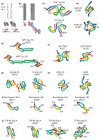Amyloid structures: much more than just a cross-β fold
- PMID: 31683043
- PMCID: PMC7617690
- DOI: 10.1016/j.sbi.2019.09.001
Amyloid structures: much more than just a cross-β fold
Abstract
In recent years our understanding of amyloid structure has been revolutionised by innovations in cryo-electron microscopy, electron diffraction and solid-state NMR. These techniques have yielded high-resolution structures of fibrils isolated from patients with neurodegenerative disease, as well as those formed from amyloidogenic proteins in vitro. The results not only show the expected cross-β amyloid structure, but also reveal that the amyloid fold is unexpectedly diverse and complex. Here, we discuss this diversity, highlighting dynamic regions, ligand binding motifs, cavities, non-protein components, and structural polymorphism. Collectively, these variations combine to allow the generic amyloid fold to be realised in three dimensions in different ways, and this diversity may be related to the roles of fibrils in disease.
Copyright © 2019 The Author(s). Published by Elsevier Ltd.. All rights reserved.
Conflict of interest statement
Nothing declared.
Figures




References
-
- Babu MM, van der Lee R, de Groot NS, Gsponer J. Intrinsically disordered proteins: regulation and disease. Curr Opin Struct Biol. 2011;21:432–440. - PubMed
-
- Fernandez-Escamilla AM, Rousseau F, Schymkowitz J, Serrano L. Prediction of sequence-dependent and mutational effects on the aggregation of peptides and proteins. Nat Biotechnol. 2004;22:1302–1306. - PubMed
-
- Knowles TP, Waudby CA, Devlin GL, Cohen SI, Aguzzi A, Vendruscolo M, Terentjev EM, Welland ME, Dobson CM. An analytical solution to the kinetics of breakable filament assembly. Science. 2009;326:1533–1537. - PubMed
Publication types
MeSH terms
Substances
Grants and funding
LinkOut - more resources
Full Text Sources
Other Literature Sources
Medical

